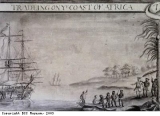African slave traders
The enslaved Africans bought by the Europeans were sold by African slave traders. In West Africa there are many different cultures and societies. Social organisation is very varied. Some of these cultures have complex social systems and others are more loosely organised. The West Africans who most prospered in the transatlantic slave trade were those from the most warlike and tightly organised societies with strong rulers who preyed on their neighbours. These societies would be more likely to wage war on their neighbouring communities, enslave prisoners of war and trade them to the Europeans.
The rulers of these societies usually appointed caboceers (traders) to deal with European slave traders. Many, such as the caboceer from the Fante people, John Currantee, or the leader from the Efik people Ephraim Robin John (known to the European traders as King George) were well-known as canny and ruthless dealers. They were able to communicate in a number of European and African languages. The African slave traders were skilled in using to their advantage the rivalries between the French, the English and the Dutch to get the best prices for their slaves. Often they demanded (and received) ‘gifts’ or ‘custom fees’, known in some quarters as ‘dashee’, from the Europeans.
Nicholas Pocock, a sea captain who became an artist, drew paintings of several ships. Some include small pictures of slave trading activity on the coast of Africa. Pictured here is a small detail from a painting called The Southwell Frigate. In it is the ship’s captain, who negotiated the purchase of slaves on behalf of the owners of the voyage. He is standing shaking hands with the African trader who has sold him the enslaved Africans being loaded into a rowing boat to be taken to the waiting slave ship.



